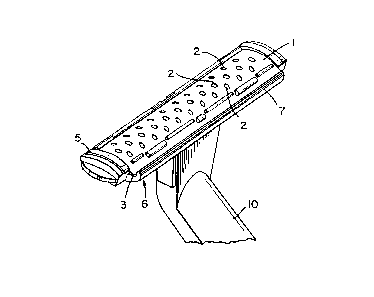Une partie des informations de ce site Web a été fournie par des sources externes. Le gouvernement du Canada n'assume aucune responsabilité concernant la précision, l'actualité ou la fiabilité des informations fournies par les sources externes. Les utilisateurs qui désirent employer cette information devraient consulter directement la source des informations. Le contenu fourni par les sources externes n'est pas assujetti aux exigences sur les langues officielles, la protection des renseignements personnels et l'accessibilité.
L'apparition de différences dans le texte et l'image des Revendications et de l'Abrégé dépend du moment auquel le document est publié. Les textes des Revendications et de l'Abrégé sont affichés :
| (12) Brevet: | (11) CA 2037895 |
|---|---|
| (54) Titre français: | RASOIRS DE SURETE |
| (54) Titre anglais: | SAFETY RAZORS |
| Statut: | Périmé et au-delà du délai pour l’annulation |
| (51) Classification internationale des brevets (CIB): |
|
|---|---|
| (72) Inventeurs : |
|
| (73) Titulaires : |
|
| (71) Demandeurs : |
|
| (74) Agent: | MACRAE & CO. |
| (74) Co-agent: | |
| (45) Délivré: | 1998-07-07 |
| (86) Date de dépôt PCT: | 1990-07-10 |
| (87) Mise à la disponibilité du public: | 1991-01-25 |
| Requête d'examen: | 1993-11-17 |
| Licence disponible: | S.O. |
| Cédé au domaine public: | S.O. |
| (25) Langue des documents déposés: | Anglais |
| Traité de coopération en matière de brevets (PCT): | Oui |
|---|---|
| (86) Numéro de la demande PCT: | PCT/US1990/003863 |
| (87) Numéro de publication internationale PCT: | WO 1991001204 |
| (85) Entrée nationale: | 1991-03-25 |
| (30) Données de priorité de la demande: | ||||||
|---|---|---|---|---|---|---|
|
Rasoir de sûreté dont la lame (1) comporte une pluralité d'ouvertures (2) à bord tranchant pour effectuer le rasage, ainsi qu'un bord rectiligne (3) pour effectuer les coupes droites. Un mécanisme permet le mouvement de la lame par rapport au manche (10) du rasoir, afin que le bord rectiligne puisse passer d'une position normalement inopérante à une position opérante. La lame est maintenue dans une position arquée, ce autorise le mouvement basculant mentionné ci-dessus.
A safety razor in which the blade (1) has a plurality of sharp-edge apertures (2) for shaving and also a sharpened rectilinear
edge (3) for trimming. Provision is made for effecting displacement of the blade relative to the razor handle (10) so that the
trimming edge which is normally in an inoperative position can be moved into an operative position. The blade is held in an
arched position so that the aforesaid movement is of a rocking nature.
Note : Les revendications sont présentées dans la langue officielle dans laquelle elles ont été soumises.
Note : Les descriptions sont présentées dans la langue officielle dans laquelle elles ont été soumises.

2024-08-01 : Dans le cadre de la transition vers les Brevets de nouvelle génération (BNG), la base de données sur les brevets canadiens (BDBC) contient désormais un Historique d'événement plus détaillé, qui reproduit le Journal des événements de notre nouvelle solution interne.
Veuillez noter que les événements débutant par « Inactive : » se réfèrent à des événements qui ne sont plus utilisés dans notre nouvelle solution interne.
Pour une meilleure compréhension de l'état de la demande ou brevet qui figure sur cette page, la rubrique Mise en garde , et les descriptions de Brevet , Historique d'événement , Taxes périodiques et Historique des paiements devraient être consultées.
| Description | Date |
|---|---|
| Inactive : CIB de MCD | 2006-03-11 |
| Inactive : CIB de MCD | 2006-03-11 |
| Le délai pour l'annulation est expiré | 2000-07-10 |
| Lettre envoyée | 1999-07-12 |
| Accordé par délivrance | 1998-07-07 |
| Inactive : Taxe finale reçue | 1998-03-23 |
| Préoctroi | 1998-03-23 |
| Inactive : Pages reçues à l'acceptation | 1998-03-23 |
| Un avis d'acceptation est envoyé | 1997-09-24 |
| Un avis d'acceptation est envoyé | 1997-09-24 |
| Lettre envoyée | 1997-09-24 |
| Inactive : Renseign. sur l'état - Complets dès date d'ent. journ. | 1997-09-22 |
| Inactive : Dem. traitée sur TS dès date d'ent. journal | 1997-09-22 |
| Inactive : CIB enlevée | 1997-08-12 |
| Inactive : CIB en 1re position | 1997-08-12 |
| Inactive : CIB attribuée | 1997-08-12 |
| Inactive : Approuvée aux fins d'acceptation (AFA) | 1997-08-11 |
| Toutes les exigences pour l'examen - jugée conforme | 1993-11-17 |
| Exigences pour une requête d'examen - jugée conforme | 1993-11-17 |
| Demande publiée (accessible au public) | 1991-01-25 |
Il n'y a pas d'historique d'abandonnement
Le dernier paiement a été reçu le 1998-06-26
Avis : Si le paiement en totalité n'a pas été reçu au plus tard à la date indiquée, une taxe supplémentaire peut être imposée, soit une des taxes suivantes :
Veuillez vous référer à la page web des taxes sur les brevets de l'OPIC pour voir tous les montants actuels des taxes.
| Type de taxes | Anniversaire | Échéance | Date payée |
|---|---|---|---|
| TM (demande, 7e anniv.) - générale | 07 | 1997-07-10 | 1997-06-30 |
| Taxe finale - générale | 1998-03-23 | ||
| TM (demande, 8e anniv.) - générale | 08 | 1998-07-10 | 1998-06-26 |
Les titulaires actuels et antérieures au dossier sont affichés en ordre alphabétique.
| Titulaires actuels au dossier |
|---|
| THE GILLETTE COMPANY |
| Titulaires antérieures au dossier |
|---|
| DAVID JOHN WILKES |
| FRANK EDWARD BROWN |
| JOHN TAYLOR |